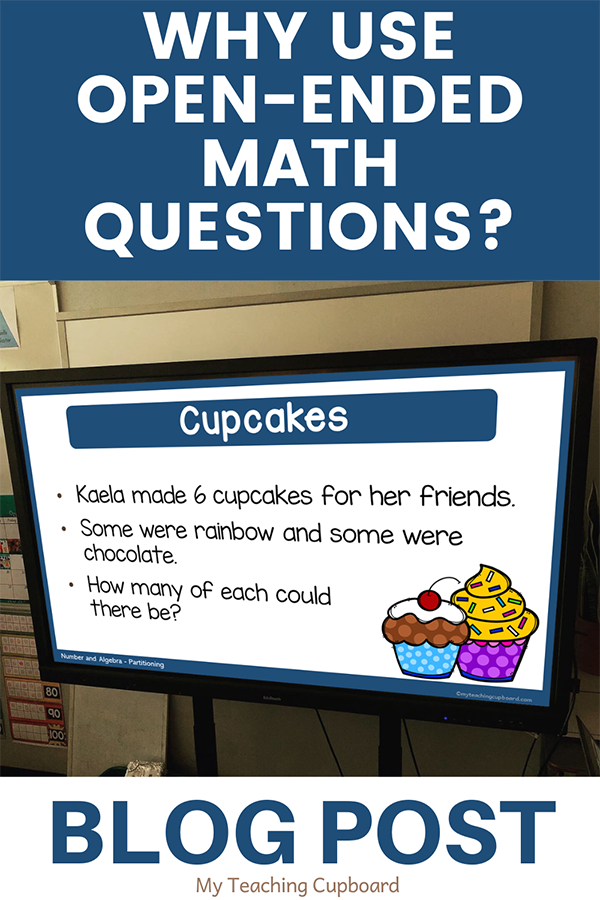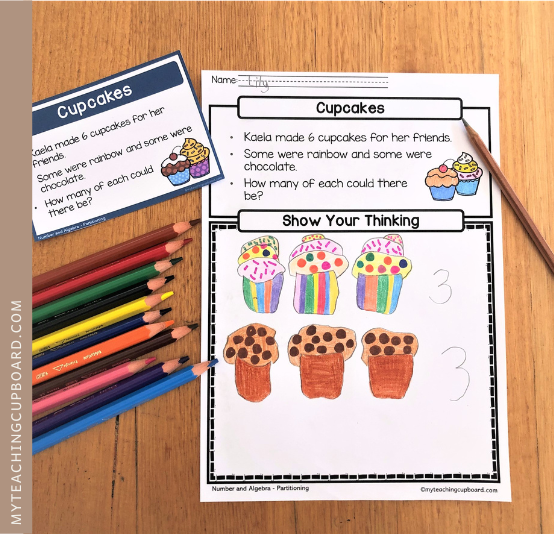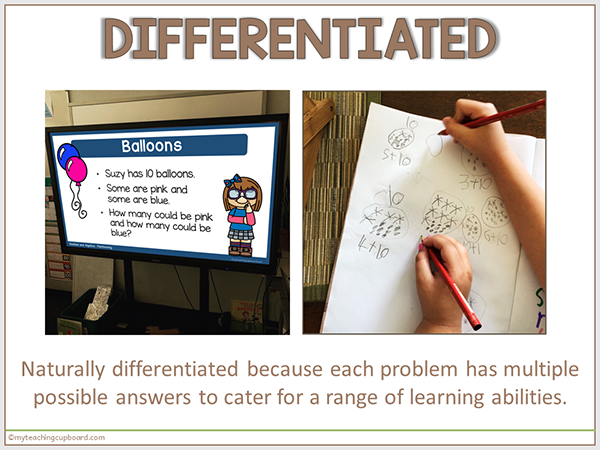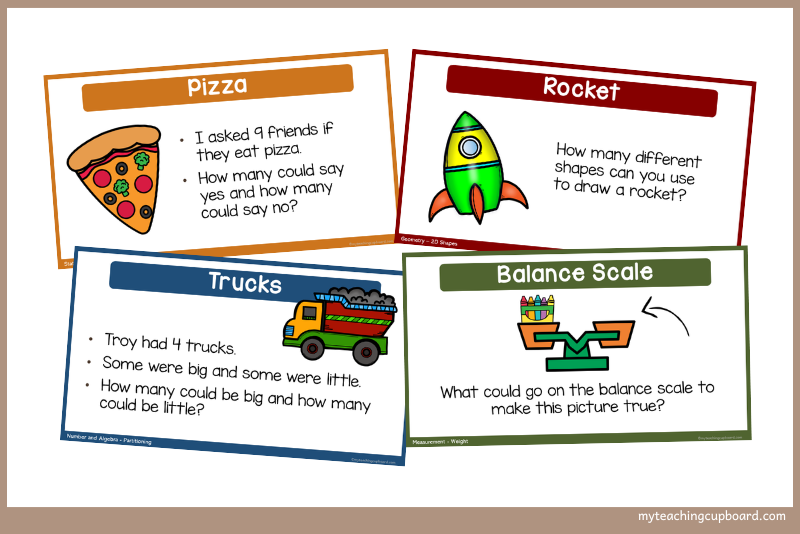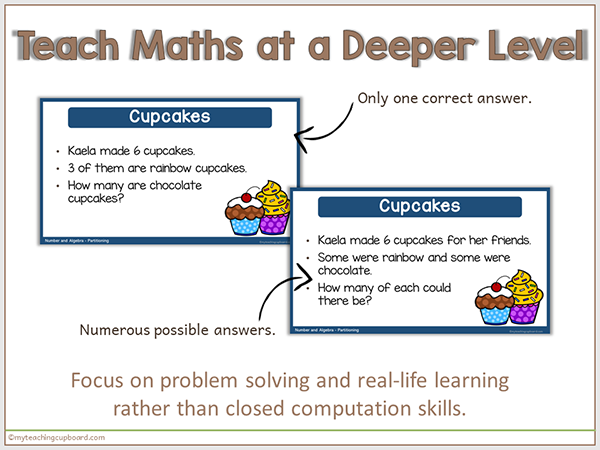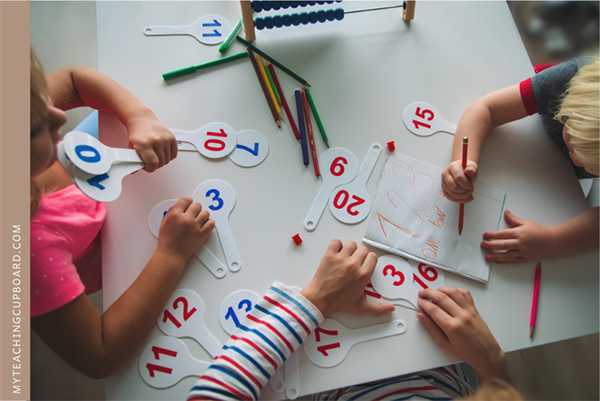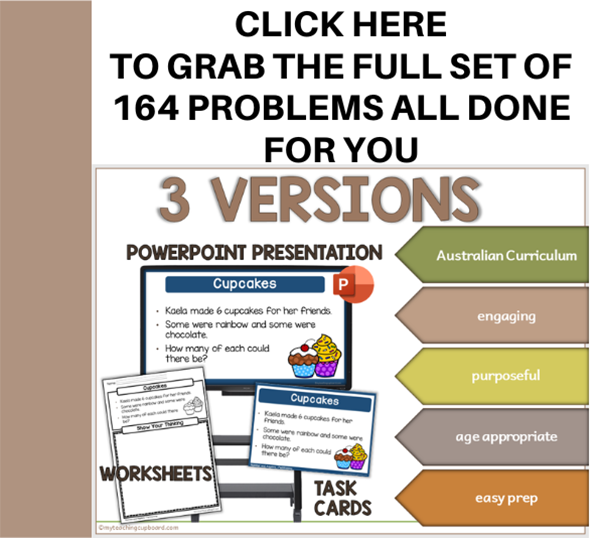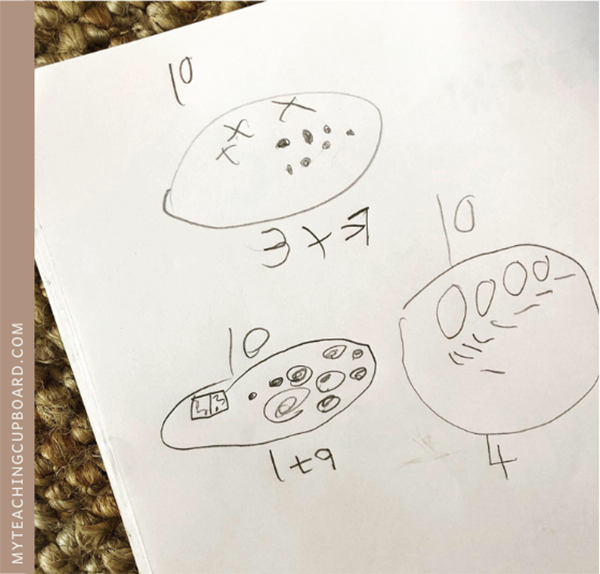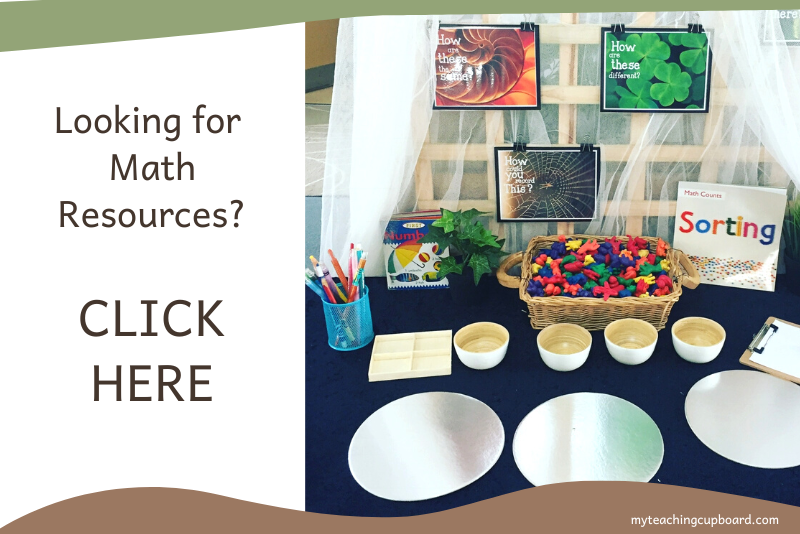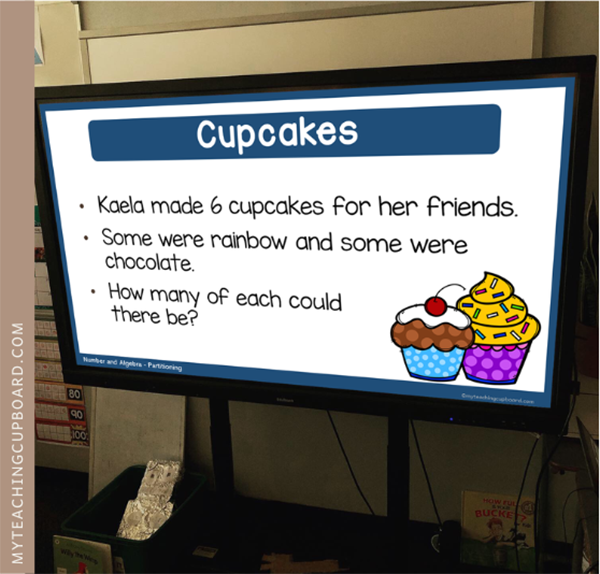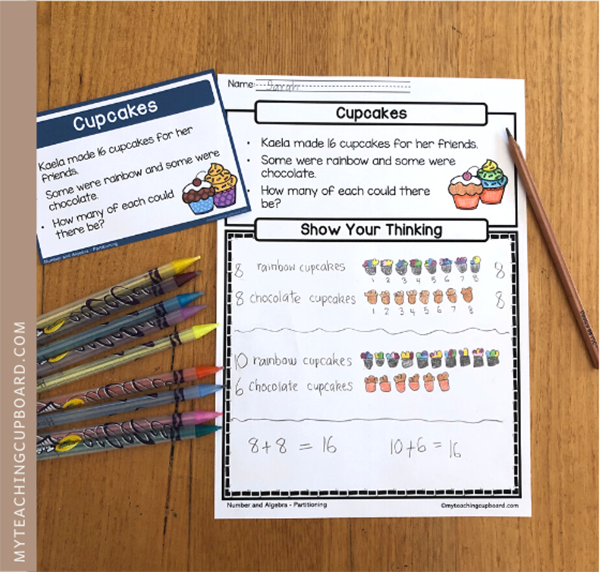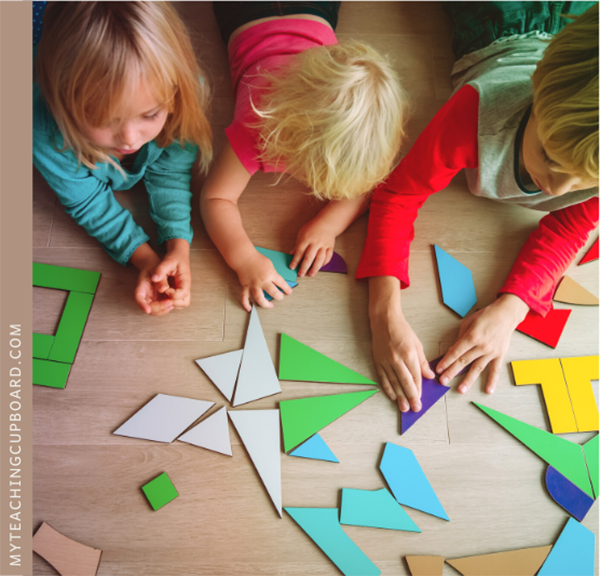Why Use Open-Ended Questions in Math?
Open-ended math problems are math questions that have more than one possible correct solution. Discover why you need to use these types of math questions with your students.
If you want your students to think deeply about mathematics, you need to be using open-ended math questions as part of your math instruction. Open-ended math problems and questions are a vital part of an effective math curriculum. This blog post will explain why they are so important and how you can use these game-changers in your classroom.
When you use open-ended math questions in your classroom, your students are going to be really thinking deeply about mathematics. They will develop their problem-solving abilities and grow in their math confidence.
Open-ended math problems provide many opportunities for math discussions, and they are incredibly engaging. Sound too good to be true? they really are that good!!
If you want your students to meet the math curriculum benchmarks and perform well on those mandated assessments, you really need to be teaching students to think mathematically and develop those important higher-order problem-solving skills.
Open-ended math questions, or open-ended math problems, will build that strong math foundation we need in the early years. When you start using these problems, you will see your kindergarten and grade one students develop a variety of problem-solving and critical thinking strategies. These are important skills we need to be teaching to not only prepare our students for their next year of schooling but also to ready them for life beyond the classroom and the twenty-first century.
What Are Open-ended Math Problems?
Open-ended math problems are math questions that have more than one possible correct solution.
These types of problems require students to think creatively and critically about mathematics because students need to draw on a variety of different mathematical skills and concepts to solve them.
They are usually presented in a word problem format and often as real-world situations. This engaging format encourages children to apply their math skills and knowledge to a relatable and meaningful situation and helps children to see why maths is important and why we need to be learning maths.
When you use open-ended math questions as part of your math teaching, your students won’t be just reciting math facts or repeating a learned procedure like they do in closed math problems. Open-ended math problems require students to use a deeper level of math thinking.
What’s the Differences Between Open-ended and Closed Math Problems?
The main difference between open-ended and closed math questions is that closed questions have only one correct answer. Open-ended questions have more than one correct answer or solution.
It’s a small difference but it has BIG implications.
An open-ended problem can take students longer to work through because they need to really think about the question and not just regurgitate a math fact.
There are also many more opportunities for valuable math discussions when you use these types of questions in your math lessons. The increase in math discussions will mean your students will be developing their mathematical language and collaborating with their peers as they problem solve.
Open-ended Math Questions Example
When you use open-ended math problems in your classroom you will be changing those traditional closed math problems from:
Kaela has 6 cupcakes. If 3 of them are rainbow, how many are chocolate?
INTO differentiated open-ended math problems with numerous possible answers like:
Kaela has 6 cupcakes. If some are rainbow and some are chocolate, how many of each could there be?
Your students will be able to show you how they are thinking. You will be surprised at the variety of math strategies your students will use.
If you are interested in learning how to write your own open-ended math questions, I have a blog post you will like: How to Write Open Ended Math Questions
Check it out to discover everything you need to know before you even start writing and then follow my 3 easy steps on how to write the best open-ended math problems.
Why Use Open-ended Questions in Math?
There are many benefits to using open-ended math tasks in the classroom. Knowing all the advantages will help you see how transformational this approach to teaching math can be.
Here are 9 reasons why you should be using open-ended math tasks in your classroom:
Open-ended math activities are naturally differentiated.
Open-ended questions are naturally differentiated because of their open-ended nature. There are a number of correct possible solutions, so every student has the chance to respond to the problem in their own way and at their own level of thinking.
Although these activities are suitable for all developmental levels, they are especially good for your higher-achieving students. The challenging nature of open-ended math activities allows more capable students to extend their thinking and demonstrate their deeper knowledge and understandings.
Because the focus in open-ended problems is not limited to providing one correct answer, students of all ability levels can experience both challenges and successes on the exact same problem.
2. Open-ended math activities are highly engaging.
Open-ended questions challenge students and as a teacher, you know how much young learners love a challenge! In fact, young children thrive when offered challenges. Problem-solving is so enjoyable to them because it’s in their nature to be inquisitive. Young children are natural problem solvers. Since they were toddlers, the root of everything they have learned has been a problem.
Engagement rises when students are given choices in their learning. Open-ended activities give children choices and control over their learning. These types of tasks allow students to work at their own pace and to make their own decisions about the way they explore and tackle the problem.
The Centers for Disease Control and Prevention found: When students feel their teachers are open to their ideas and allow them to make choices regarding their learning and schoolwork, they are more engaged in school, less disruptive in class, and report feeling a stronger sense of belonging and connectedness to their school.
3. Open-ended math tasks shift the teaching focus from computation to problem-solving and real-life learning.
When you use open-ended math tasks, the focus is on the learning process, rather than just the final answer product. Students begin to use their mathematical knowledge and skills comprehensively and at a much deeper level.
Students will also connect their prior math learning experiences to these new mathematical problems and explore mathematics within a real-life problem context rather than as an abstract task.
Studies by Attali & Powers (2010) suggest that using open-ended math tasks has an obvious positive impact on students’ impressions about learning mathematics and creates opportunities for real-world applications of math.
Open-ended problems are much better representations of the true nature of mathematics. Research mathematicians actually apply this exact same problem-solving approach in their daily work so it makes sense that we should use these strategies in our classrooms too.
4. Open-ended math activities give students practice recording their thinking and math understandings.
Children are often expected to record their thinking when they work through open-ended math problems. Giving students the opportunity to practice recording their math thinking in a natural and non-threatening way is especially important in the early years of schooling. It is necessary that young learners are given this opportunity because much of their future math schooling will expect them to demonstrate and explain their math thinking and working out.
5. Open-ended math work creates a record of each student’s growth and progress.
Children in kindergarten and grade one will very often record their thinking and problem-solving strategies when they work through open-ended math problems. Their written work often takes the form of drawings and illustrative models of their mathematical thinking.
This written work provides valuable and specific information to the teacher about each student’s math understandings and how the students apply their math knowledge in a problem-solving context.
6. Open-ended math questions develop growth mindsets and higher-order thinking skills.
Open-ended math questions will challenge your students to learn more about how they think. These types of math questions encourage extended responses and expect students to reason, think and reflect as they problem solve. Your students will have ample opportunities to practice and fine-tune their problem-solving, reasoning, critical thinking, and communication skills.
Open-ended questions encourage students to take some chances and calculated risks with their learning. This risk-taking and the trial-and-error strategies that go with higher order problem-solving help to promote a growth mindset in young children and this is one of the greatest gifts you can give a child. If you are interested in learning more about problem-solving and promoting growth mindsets in your students, you might be interested in this blog post: Affirmations & Growth Mindsets for Children
7. Open-ended math problems give the teacher insight into students’ mathematical abilities, opinions, understandings, and misconceptions.
Because open-ended math questions are not like traditional closed questions, children don’t feel the pressure to solve the problem by finding the one and only right answer. Using open-ended questions that have multiple correct answers helps to create a relaxed learning environment that feels safe for mathematically anxious children.
When children work in a learning environment that feels safe, they are much more likely to freely express their mathematical understandings. When students record and discuss their thinking and as they work through open-ended math problems, you will be provided with some valuable documentation and insights into their true mathematical abilities, opinions, understandings, and misconceptions.
You can use this evidence of learning as a formative assessment tool too. You’ll be surprised at how much you can learn about your students just from your observations and their written work. You’ll notice
how accurate their computation skills are
if they can flexibly apply more than one math strategy to solve a problem
if they have misconceptions that may be affecting their math understandings
how well they can communicate their thinking
and how well they can work with others.
The rich information you gather while children work on their open-ended math problems can inform your future planning and math instruction as well as provide valuable evidence of learning at reporting time and parent-teacher interviews.
8. Open-ended math tasks build students’ math confidence.
Problem-solving on its own encourages students to believe in their ability to think mathematically because they can see that they can apply their already learned math knowledge to solve problems. This is empowering and encourages students to extend their learning and reflect on their thinking.
When you add the open-ended aspect to their problem-solving, it is much easier to encourage reluctant students to “have-a-go” and develop math self-confidence. Sometimes traditional math exercises can be a little daunting to young kindergarteners and first graders but ones like these that have no one correct answer can encourage children to share their own thoughts and make them more confident math learners.
When students can work at their own level and in their proximal level of development like they do on open-ended math problems, they will always feel successful and capable in their math skills.
9. Open-ended problems build students’ math language and communication skills.
When you provide opportunities for your students to work with a partner to solve open-ended math problems or when you have class discussions to reflect on the math problems, you will be providing opportunities for your students to build their communication skills and practice using that all-important math metalanguage.
Students always enjoy discussing their thinking. Allowing time for your students to share their problem-solving strategies and give other students reasons for their solutions will take your math lessons to the next level.
Opportunities for students to verbally extend their learning and reflect on their own thinking through whole group discussions or partner talks will always foster and extend learning, creativity, collaboration, and engagement in students.
Using Open-ended Math Questions in Kindergarten and Grade 1
Now you know how beneficial open-ended questions are for your math instruction, it’s time to think about how you can use them in your Kindergarten or Grade 1 classroom.
Here are 4 ways you can implement open-ended math problems in your early year's classroom:
As a Warm-up:
Open-ended math problems make fantastic math warm-ups because they are highly engaging and act as a great hook to your math lesson. Get your students thinking mathematically right at the start of your maths block by exploring an open-ended math question.
I like to display mine on a large interactive panel. I’ll read the problem and then invite students to work with a partner to solve it. I usually give them 5 to 10 minutes to record their thinking before meeting back together to share their work and their reasoning.
2. As an Independent Math Rotation Activity
We do math rotations and centers every day and I’m always looking for valuable math learning activities for students to work on independently during this time.
When you have practiced a few open-ended math problems together as a class and had the chance to model how to work them out, your students will be ready to tackle these problems on their own.
I still encourage my students to work with a partner to solve each problem even though it’s labelled an independent activity on my timetable. The rich learning and math talk that happens when children work with a partner is just too valuable to pass up.
These worksheets and matching task cards are the perfect resources for math rotations and centers. I like to display the matching colour task card for the children to refer to and then provide the worksheets for the students to record their thinking on.
3. As a Small Group Teacher Lesson during Math Rotations
When you get the chance to discuss and solve an open-ended problem together in a small group there are many more opportunities for accurate teacher observations and purposeful instruction. I love using open-ended math problems with small groups as the math talk is always rich and I feel I really get to know how my little mathematicians are thinking.
I will use the same set of open-ended problem task cards and worksheets that we use for independent work. Again, it’s easy and quick to display the small task card for the children to refer to, and then we use the worksheets to record our thinking.
4. As a Provocation for a Math Investigation Area or Math Center
The little coloured task cards make great math provocations at our maths investigations table. There are usually related real-world props I can add to the area to help children engage and relate to the open-ended problem.
I also add a few different manipulatives like counters or unifix blocks so children have some hands-on tools to use if they wish. Sometimes I’ll add a related text to the area too.
Makes for such an easy setup. This math area is always a great investigation area to discuss at reflection time. So much learning happens here.
Use these 164 open-ended math problems in your whole class and small group math warm-ups and guided math lessons. They will make teaching problem-solving quick and easy. These word problems are all fully aligned to the Australian Curriculum – Foundation stage.
Each naturally differentiated math question has multiple answers to cater for a range of learning abilities so you’ll be able to keep your young students engaged and excited about maths.
They are age-appropriate math tasks designed around popular kindergarten topics and interests your students will love.
We usually do one or two of these problems each week and with 164 open-ended questions in this resource, you will have more than enough for the whole year!
Using open-ended questions in maths is such an important part of a well-rounded math curriculum so I created this massive set of problems to make it easier for you to teach this vital strategy . Problem-solving is one of the most important math skills children need exposure to for all those reasons I’ve outlined above.
Remember when using open-ended math questions like these, the focus needs to be on the strategies your students are using and not just the answer to the problems. Success at open-ended math tasks is all about the math skills and understandings your students employ rather than superficial indicators like speed or correctness of answers.
When you provide opportunities for discussions and ask your students to explain their thinking, you will be developing important math skills as well as gaining valuable insights into the math understandings your students have.
Now you have some ideas on how to get your students thinking deeply about mathematics and why you should be using open-ended math questions in your classroom, it’s time to timetable a problem-solving slot in your planning. You won’t regret it I promise!!
If you found this blog post on open-ended math questions helpful, please consider sharing it… Just CLICK the sharing box below.👇

